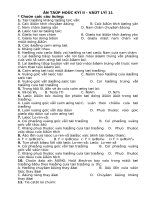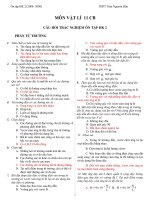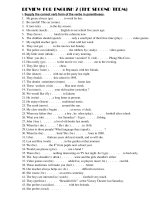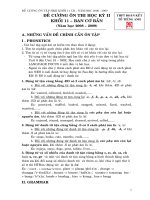đề cương ôn tâp 11 (hot)
Bạn đang xem bản rút gọn của tài liệu. Xem và tải ngay bản đầy đủ của tài liệu tại đây (138.24 KB, 14 trang )
ĐỀ CƯƠNG ÔN TẬP HKII KHỐI 11 CB – NĂM HỌC 2008 - 2009
ĐỀ CƯƠNG ÔN THI HỌC KỲ II
KHỐI 11 – BAN CƠ BẢN
(Năm học 2008 – 2009)
A. NHỮNG VẤN ĐỀ CHÍNH CẦN ÔN TẬP
I . PHONETICS
- Các bài tập ngữ âm sẽ kiểm tra theo theo 2 dạng:
1. Tìm từ cóphần gạch chân phát âm khác với các từ còn lại.
2. Tìm từ có vò trí trọng âm ở âm tiết có vò trí khác với các từ còn lại.
- Từ vựng cho bài tập phần ngữ âm lấy chủ yếu ở các đơn vò bài học từ
Unit 9 đến Unit 15 – SGK. Học sinh chú ý các từ vựng trong phần
LANGUAGE FOCUS ở mỗi đơn vò bài học.
- Ngoài ra cần chú ý thêm cách phát âm ED ở cuối động từ và cách phát
âm S/ES ở cuối danh từ hay động từ. Sau đây là hướng dẫn cách đọc ED/
S/ ES ở cuối động từ / danh từ:
1. Động từ tận cùng bằng -ED có 3 cách phát âm là: /id/, /t/, /d/.
a. Đối với những động từ tận cùng là: -t, -d, khi thêm -ED sẽ phát âm
là /id/.
Ex: wanted, collected, decided, needed,.......
b. Đối với những động từ tận cùng là: -c, -f, -k, -p, -s, -x, -sh, -ch, khi
thêm -ED sẽ phát âm là /t/.
Ex: practiced, stuffed, looked, stopped, missed, fixed, washed,
watched,.......
c. Đối với những động từ tận cùng là các phụ âm còn lại hoặc
nguyên âm, khi thêm -ED sẽ phát âm là /d/.
Ex: enjoyed, stayed, managed, cleaned, arrived, called,.......
2. Động từ/ danh từ tận cùng bằng -S có 2 cách phát âm là: /s, /z/.
a. Đối với những động từ/ danh từ tận cùng là: -p, -f, -th, -k, -t khi
thêm -S sẽ phát âm là /s/.
Ex: stops, books, cuts, months, roofs,.......
b. Đối với những động từ/ danh từ tận cùng là các phụ âm còn lại
hoặc nguyên âm, khi thêm -S sẽ phát âm là /z/.
Ex: enjoys, stays, dogs, pens, tables, lives,.......
3. Động từ và số nhiều của danh từ tận cùng bằng s, ss, sh, ss, ch
hoặc x, ce, ge và một vài danh từ tận cùng bằng o hình thành bằng cách
thêm es khi đổi sang số nhiều (danh từ) và thêm es, khi chia ở ngôi thứ 3 số
ít thì HTĐơn (động từ) sẽ đọc là /iz/
Ex: : watch - > watches [wɔt∫iz], place -> places /ple1s1z/ , change ->
changes /’t~éind21z/ , houuse -> houses / ha$s1z /, tomato-> tomatoes bus ->
buses / b^s1z/, brush-> brushes , kiss -> kisses , box-> boxes
II. GRAMMAR
1
THPT ĐOÀN KẾT
TỔ TIẾNG ANH
ĐỀ CƯƠNG ÔN TẬP HKII KHỐI 11 CB – NĂM HỌC 2008 - 2009
Gồm những điểm văn phạm trong chương trình SGK khối 11, trọng tâm
chính là học kỳ 2 và một số thì động từ căn bản.
1. Defining relative clauses and Non- defining relative clauses
a. Defining relative clauses: Mệnh đề liên hệ hạn đònh
Note:
- Bắt đầu bằng who, whom, which có thể được thay bằng that.
- Bắt đầu bằng whose có thể thay thế cho of which
Ex:
+ The girl WHO/THATwas injured in the accident is now in hospital.
+ The car WHICH/THAT my father bought yesterday was made in Japan.
b. Non- defining relative clauses: Mệnh đề liên hệ không hạn đònh.
Note:
Chúng ta ko dùng THAT và ko thể bỏ WHO hoặc WHICH.
Chúng ta phải đặt dấu phẩy ngay phía trước mệnh đề tính từ ko hạn
đònh và ngay phía sau nó. Mệnh đề tính từ ko hạn đònh nằm giữa hai dấu
phẩy.
- Yesterday I met Hoa, who told me, she was getting married.
Cách đơn giản để xác đònh mệnh đề không hạn đònh là danh từ đứng
trước mệnh đề hạn đònh thường là:
+ Tên riêng: Nam Cao, who wrote “ Chi Pheo” was a famous Vietnamese
writer.
+ Có tính từ sở hữu đứng trước: My father, who lives in the country, was a
famer.
+ V-ing: Swimming, which I practise everyday, is my favourite sport.
2. Relative Pronouns with prepositions: Mệnh đề quan hệ có giới
từ.
Note: THAT không bao giờ đứng sau giới từ
3. Relative clauses replaced by participles and to infinitives
Ta có thể lược bỏ đại từ quan hệ bằng cụm hiện tại phân từ (V-ing phrase)
cho hành động ở chủ thể chủ động hoặc cụm qúa khứ phân từ (past
participle phrase) cho hành động ở thể bò động.
a. Active participles:
Ex: - The girl who is playing with the dog is Lan’s sister.
The girl playing with the dog is Lan’s sister.
Ex: Do you know the woman who is coming toward us?
Do you know the woman coming toward us?
Ex: The people who live in my neighbourhood are very friendly.
The people living in my neighbourhood are very friendly
b. Passive participles :
Ex: The picture which was drawn by a blind has won the first prize.
The picture drawn by a blind has won the first prize.
c. Infinitive relative clauses:
Ex: The last person who leaves will have to turn out the lights.
2
ĐỀ CƯƠNG ÔN TẬP HKII KHỐI 11 CB – NĂM HỌC 2008 - 2009
=> The last person to leave will have to turn out the lights.
Ta thường sử dụng a to- infinitive sau các từ thứ tự như ( first, second…), sau
next and last, after, only, và sau tính từ cực cấp (so sánh nhất).
4. Cleft sentences : Câu nhấn mạnh
a . Subject focus: Nhấn mạnh chủ từ
Form : It is / was + S + who/that + V ……………chính ai đó làm gì …
Ex: It was the man who gave her the book.
It was the dog that hit me.
b. Object focus: Nhấn mạnh túc từ
Form : It is / was + O + who/ that + S + V …….chính ai đó / một cái
gì đó một ai đã làm ….
Ex: It was the man who (m) I gave the book.
It was the dog that the boy hit.
c. Adverbial focus
Form : It is /was + A + that + S + V + ( O)….. chính lúc nào đó ai đó /
một cái gì đó làm gì……
Ex: It was in this house that I was born.
It was in Dong Nai that I met my wife.
d. Cleft sentences in the passive voice
Form : It + be + S + that + be + V
3
( S = O passive )
Ex: It was the car that bought by my father yesterday.
5. Conjunctions: Các cụm từ nối câu
Ta có thể sử dụng các cụm từ nối : both ………and ( vừa ……vừa ) , not
only ……but also ( không những …….mà còn ) , either …….or ( hoặc
…….hoặc ) , neither …….nor ( không ……..mà cũng không ) để nối hai từ đồng
loại ( danh từ , động từ , tính từ hoặc các cụm từ… ) với nhau
6. Tag Questions: Câu hỏi láy
7. Một số thì động từ cơ bản:
1. The simple peresent tense
2. The simple past
3. The past progressive
3. The present perfect
4. The past perfect
APPLIED EXERCISES
I. PHONETICS
Choose the word whose underlined part is pronounced differently
from that of the others in each group
1. A. comment B. solar C. ecologist D. fossil
2. A. tooth B. with C. both D. tenth
3. A. come B. capture C. coexist D. appreciate
3
Các bài tập về thì có khoảng 2
-> 3 câu trắc nghiệm
ĐỀ CƯƠNG ÔN TẬP HKII KHỐI 11 CB – NĂM HỌC 2008 - 2009
4. A. nature B. Asian C. squash D. spacious
5. A. about B.would C.round D.out
6. A.chair B.machine C.check D.child
7. A. support B. shuttle C. success D. venture
8. A. dread B. bead C. bread D. thread
9. A. reserve B. conserve C. release D. research
10. A. machine . B. sugar C. sure D. expensive
11. A. polluted B.prevented C. needed D. advised
12. A. amount B. count C. without
D. source
13. A. robbed B. worked C. jumped
D. stopped
14. A. builds B. plants C. answers D.
animals
15. A. replies B. houses C. buses D. catches
16. A. plays B. pays C. says D. stays
17. A. tapes B. tables C. cassettes D. cases
18. A. hooks B. cattles C. lamps D. cliffs
19. A. month B. seventh C. that D. think
20. A. watched B. reached C. managed D. marched
Choose one word whose stress pattern is different. Identify your
answer by circling the corresponding letter A, B, C or D:
1. A. eradicate B. expand C. announce D. satisfy
2. A. distribute B. stimulate C. subscribe D. affect
3. A. distance B. daily C. surface D. equip
4. A. capture B. endanger C. coexist D. devastate
5. A. extinct B. decrease C. affect D. influence
6. A. prohibit B. increase C. transfer D. announce
7. A. advance B. aquatic C. discharge D. deepen
8. A. gymnast B. gymnasium C. knowledge
D. maintenance
9. A. consumption B. ecologist C. pesticide D.
endangered
10. A. compare B. compose C. company D. consist
11. A. ambulance B. yesterday C. furniture D. policeman
12. A. constant B. continent C. consider D. content
13. A.computer B. museum C. important D. visitor
14. A.display B. lecture C.different D. grocery
15. A. maintenance B. geothermal C. satisfaction
D. prohibition
II. VOCABULARY & PREPOSITIONS
Choose the best option to complete the sentences
1. Big cities are always ______ to young people
A. interested B.fascinating C.fascinated D.attractively
4
ĐỀ CƯƠNG ÔN TẬP HKII KHỐI 11 CB – NĂM HỌC 2008 - 2009
2. Those athletes competed with all their best to get ………………
A. friendship B. cultures C. medals D. advance
3. ……… heat comes from deep inside the earth.
A. Geothermal B. Solar C. Nuclear D. Hydro
4. It is my teacher that I am grateful ……………
A. for B. at C. about D. to
5. She . . . complains about her housework
A. continual B. continually C. continues D. continuing
6. How many countries …………………… in the last Asian Games?
A. took part B. participated C.
entered D. A or B
7. Swimming and water skiing are both ………………… sports.
A. aquatic B. advancing C. squash D.
rugby
8. It’s cheaper if you book the tickets ……………… advance.
A. at B. in C. by D. for
9. Watching television is by far the most popular . . . . . . .
A. intensity B. occupation C. recreation D. passion
10. I am very . . . . . . . . in the information you have given me.
A. interested B. surprised C. depressed D. concerned
11. We were all attracted . . . . . . . . the beauty of nature there.
A. in B. to C. with D. on
12. The performance of the dolphin was very . . . . . .
A. bored B. spectacular C. avid
D. artificial
13. It is technology that will play a key role in future lifestyles.
A. to shape B. shaping C. shape of
D. shaped
14. I just collect stamps from discarded envelopes
A.thrown away B.given up C.got away D.done up
15. The beach is crowded ……………………… tourists in summer .
A. in B. for C. on D. with
16. …………. ………from all over the world take part in the Olympic Games.
A. Athlete B. Athletic C. Athletes D. Athletics
17. Many people like football because it is a very……………………sport.
A. strong B. aquatic C. unfair D.
competitive
18. He never had the ………………… of seeing his paintings recognized and
admired.
A. satisfy B. satisfying C.
satisfaction D. satisfactory
19. Collecting dolls is her …………………… hobby.
A. favourite B. preferred C.
liked D. popular
5









